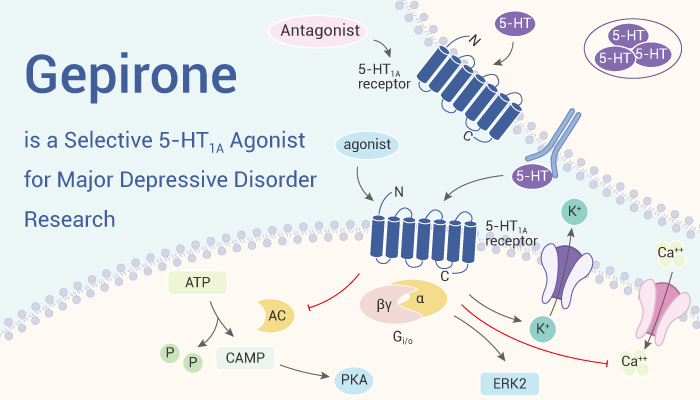5-HT receptors (Serotonin receptors) are a group of G protein-coupled receptors (GPCRs) and ligand-gated ion channels (LGICs) found in the central and peripheral nervous systems. They mediate both excitatory and inhibitory neurotransmission. The serotonin receptors modulate the release of many neurotransmitters, as well as many hormones. Meanwhile, The serotonin receptors influence various biological and neurological processes such as aggression, anxiety, appetite, cognition, learning, memory, mood, nausea, sleep, and thermoregulation.
5-HT1A receptor is a subtype of serotonin receptors, or 5-HT receptors, that binds serotonin, also known as 5-HT, a neurotransmitter. The 5-HT1A receptor is the most widespread of all the 5-HT receptors. In the central nervous system, 5-HT1A receptors exist in the cerebral cortex, hippocampus, septum, amygdala, and raphe nucleus in high densities, while low amounts also exist in the basal ganglia and thalamus. The 5-HT1A receptors in the raphe nucleus are largely somatodendritic autoreceptors, whereas those in other areas such as the hippocampus are postsynaptic receptors. It is a GPCR, coupled to the Gi protein, and its activation in the brain mediates hyperpolarization and reduction of firing rate of the postsynaptic neuron. 5-HT1A receptor agonists are involved in neuromodulation. They decrease blood pressure and heart rate via a central mechanism, by inducing peripheral vasodilation, and by stimulating the vagus nerve. Besides, activation of central 5-HT1A receptors triggers the release or inhibition of norepinephrine. What’s more, 5-HT1A receptor agonists show efficacy in relieving anxiety and depression.

Gepirone is a selective, affinitive and orally active 5-HT1A agonist
Gepirone binds selectively to 5-HT1A receptor binding site. An active metabolite of Gepirone, 1-(2-pyrimidinyl)piperazine, is an α2-adrenergic receptor antagonist. In rats, Gepirone activates the normosensitive postsynaptic 5-HT1A receptor in Male Sprague-Dawley rats. What’s more, Gepirone interacts with progesterone at 5-HT1A receptors to reduce lordosis behavior in female rats treated with Estradiol benzoate and Progesterone. Therefore, Gepirone acts as an antidepressant agent that is effective in anxiety and major depressive disorder research.
All in all, Gepirone is a selective, affinitive and orally active 5-HT1A agonist. Gepirone is effective in anxiety and major depressive disorder research.
References:
[1] Albert PR, et, al. Neuroscientist. 2004 Dec;10(6):575-93.
[2] Gill AK, et, al. Drugs Today (Barc). 2019 Jul;55(7):423-437.